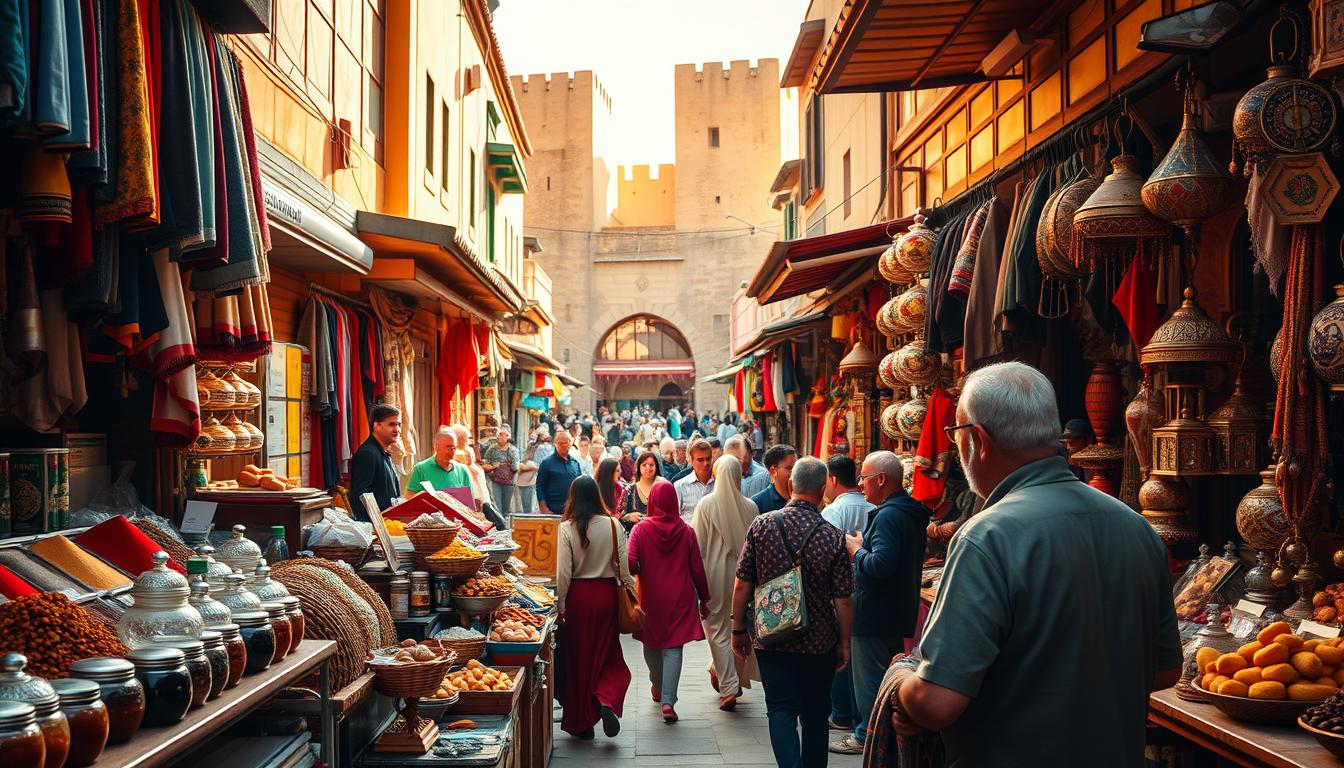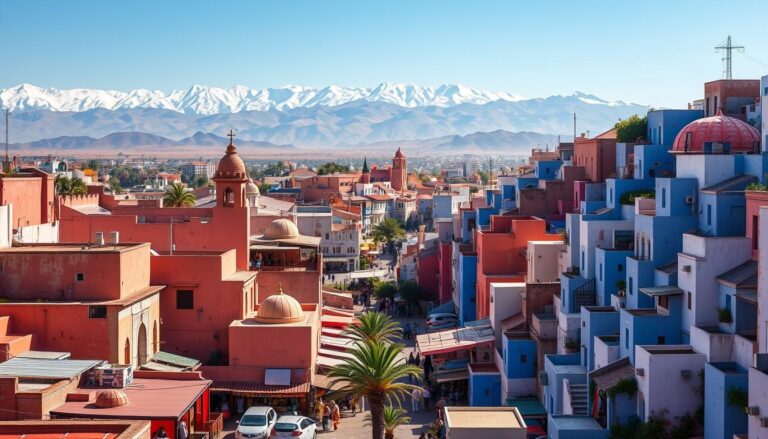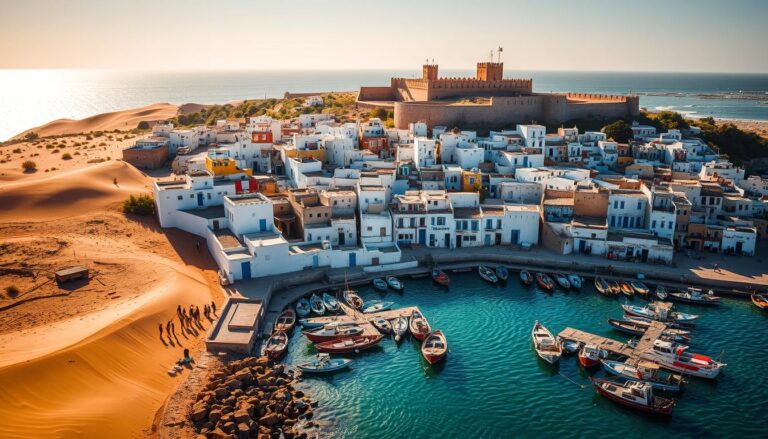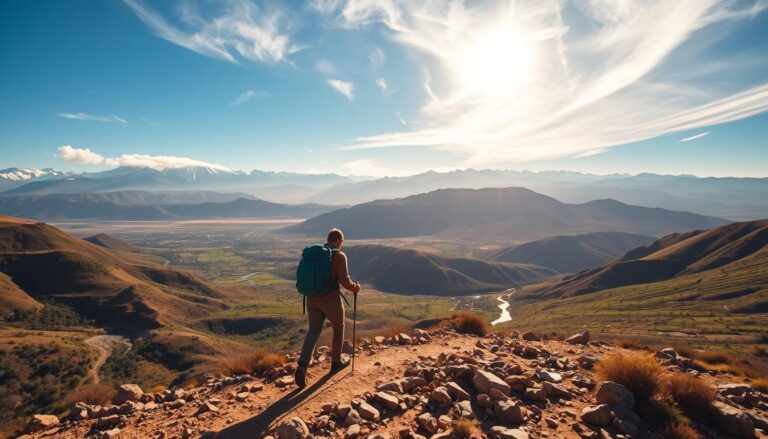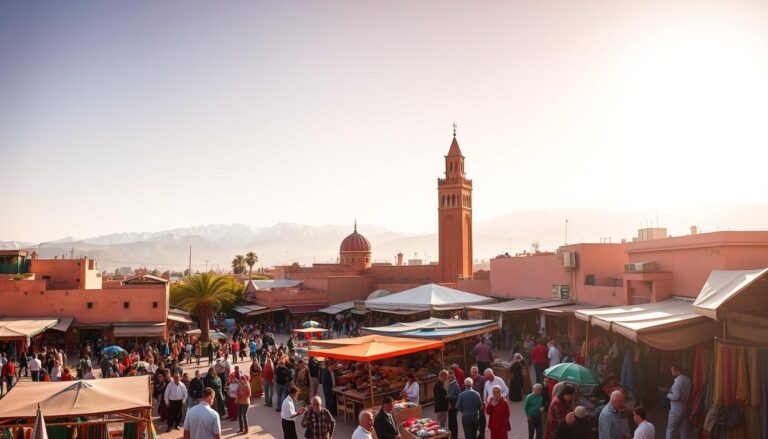When’s the Best Time to Visit Morocco?
Table of Contents
Morocco is a favorite spot for travelers from all over, including the UK. It’s known for its rich culture and stunning views. That’s why Morocco travel tips are so sought after.
Did you know the right time to visit can make all the difference? Morocco’s weather changes a lot, from cool, wet winters to hot, dry summers. So, picking the best time to visit Morocco is key.
Are you into city life, beach relaxation, or mountain treks? Knowing when to go to Morocco is vital for a great trip.
Key Takeaways
- Morocco’s diverse climate affects the travel experience.
- Choosing the right time to visit is crucial for enjoying activities.
- Understanding the country’s geography helps in planning.
- Morocco travel tips can enhance your trip.
- Researching the best time to visit can save you from unpleasant weather conditions.
Understanding Morocco’s Climate and Geography
Knowing Morocco’s climate is crucial for planning your trip. The country’s varied landscapes, from the Atlas Mountains to the Sahara Desert, shape its weather. Each area has its own climate.
The Four Distinct Climate Zones
Morocco has four main climate zones. Each offers a unique experience for visitors. You’ll find Mediterranean, Atlantic, continental, and desert climates across the country.
- Mediterranean Climate: This climate is known for hot summers and mild winters, found in the north.
- Atlantic Climate: Coastal areas have a milder climate, with cooler summers and warmer winters.
- Continental Climate: The Atlas Mountains have cold winters and warm summers.
- Desert Climate: The Sahara Desert is very hot during the day and cold at night.
How Geography Affects Weather Patterns
Morocco’s geography greatly influences its weather. The Atlas Mountains, for example, block rain, making areas south of them dry.
| Region | Climate Characteristics | Best Time to Visit |
|---|---|---|
| Coastal Areas | Mild winters, cool summers | Spring (March-May) and Autumn (September-November) |
| Mountainous Regions | Cold winters, warm summers | Summer (June-August) for hiking, Winter (December-February) for snow sports |
| Desert Regions | Hot days, cold nights | Winter (December-February) for comfortable temperatures |
Understanding Morocco’s climate zones and how geography affects weather helps plan your trip. This way, you can have a more enjoyable and comfortable journey.
The Best Time to Visit Morocco: Season by Season
Morocco’s climate varies, so the best time to visit depends on what you want to do. The country’s geography, from coast to desert, makes each season unique.
Spring (March-May): Ideal Weather and Blooming Landscapes
Spring is a top time to see Morocco. The weather is mild, and the landscapes are in full bloom. The Atlas Mountains are stunning, with wildflowers everywhere. It’s perfect for hiking and trekking before it gets too hot.
Summer (June-August): Heat, Crowds, and Coastal Retreats
Summer is when Morocco gets the most tourists. Schools are on break, and families head to places like Essaouira and Agadir. The coast is cooler, but it’s also the busiest time. Popular spots can get very crowded.
Autumn (September-November): Pleasant Temperatures and Harvests
Autumn is another great time to visit. The weather is nice, and the harvest season is in full swing. The Sahara Desert is cooler, and the landscapes are green from the summer rains. It’s also a time for cultural events and festivals.
Winter (December-February): Mild Coastal Weather and Snowy Mountains
Winter in Morocco is different depending on where you are. The coast is mild, while the Atlas Mountains get snow. Coastal cities like Casablanca and Rabat are good escapes from cold European winters. It’s off-peak, so you might find better deals on places to stay.
Knowing about the seasons helps plan your trip to Morocco. You can choose the busy peak season or the quieter off-peak times for a more relaxed and affordable trip.
Regional Weather Guide: Where to Go When
Knowing the weather in Morocco is key for a great trip. The country’s varied landscapes mean different climates in each area. So, picking the right time to visit is crucial.
Coastal Cities (Casablanca, Rabat, Essaouira)
The coastal cities of Morocco have a mild climate all year. Casablanca and Rabat have moderate temperatures, with warm summers and mild winters. Essaouira is windy, perfect for surfers and those who love cool breezes.
Imperial Cities (Marrakech, Fez, Meknes)
The imperial cities are steeped in history and culture. Marrakech, Fez, and Meknes have a more continental climate. They have hot summers and cool winters. Spring and autumn are the best times to visit, with comfortable temperatures.
Atlas Mountains and Mountain Towns
The Atlas Mountains are cooler, ideal for escaping summer heat. Towns like Imlil and Ourika Valley are great for hiking and learning about Berber culture. Visit in spring or summer for the best trekking and outdoor fun.
Sahara Desert Region
The Sahara Desert is vast and very hot. Winter is the best time to explore, with milder temperatures. It’s perfect for desert trips and camel rides.
Understanding Morocco’s weather helps plan your trip. You’ll enjoy the activities and sights each area offers.
Peak Tourist Seasons: Pros and Cons
Knowing when the peak tourist seasons are in Morocco can greatly affect your trip. The country’s tourism is shaped by weather, global events, and cultural celebrations.
When planning a trip to Morocco, it’s important to consider the good and bad of peak and off-peak seasons. The country’s varied climate and geography mean different areas have different busy times.
High Season (April-May, September-October)
The high season in Morocco is in spring (April-May) and autumn (September-October). These months have nice weather, perfect for seeing the cities, historic sites, and nature.
Traveling in the high season has its perks:
- Pleasant weather
- Many tourist facilities and services
- Cultural events and festivals
But, there are downsides too:
- Bigger crowds and longer lines at popular spots
- Higher costs for places to stay and tourist services
| Aspect | High Season (April-May, September-October) |
|---|---|
| Weather | Pleasant, mild temperatures |
| Crowds | Larger crowds, especially at popular attractions |
| Prices | Higher prices for accommodations and tourist services |
Low Season (November-March, except holidays)
The low season in Morocco, from November to March (except holidays), is quieter. Some places might be closed or open less, but the lower prices and fewer people can be appealing.
Traveling in the low season has its advantages:
- Lower prices for places to stay and tourist services
- Fewer crowds for a more relaxed visit
But, there are also some downsides:
- Some places might be closed or open less
- Weather can be cooler and wetter in some areas
In the end, the best time to visit Morocco depends on what you want. Knowing the pros and cons of peak and off-peak seasons helps you plan a great trip.
Traveling During Ramadan: What to Expect
Traveling to Morocco during Ramadan needs some planning to respect local customs. Ramadan is a big deal in Morocco, where people fast from dawn to sunset. It’s important to understand and respect this tradition for a smooth visit.
Ramadan Customs and Business Hours
Many businesses change their hours during Ramadan. Shops and cafes open later, around 9 or 10 PM. They stay open late to let people eat after sunset, called iftar.
Some things to keep in mind include:
- Don’t eat, drink, or smoke in public during the day to respect those fasting.
- Wear modest clothes to honor the local culture.
- Be ready for businesses to open earlier or later.
One traveler said, “Ramadan evenings in Morocco are lively. Streets are full of people sharing iftar. It’s a special experience that enriches your visit.”
“The month of Ramadan is a time for spiritual reflection, but it’s also a period of great communal celebration in Morocco.”
Benefits and Challenges for Tourists
Visiting Morocco in Ramadan has its ups and downs. The good parts include:
| Benefits | Challenges |
|---|---|
| A unique cultural experience | Some tourist spots might have shorter hours |
| Vibrant evening scenes | Less service during the day |
| Chances to connect with locals | Need to be mindful of fasting people |
With the right attitude and planning, Morocco in Ramadan can be a rewarding trip. It offers a unique look at the country’s culture and traditions.
Must-Visit Festivals and Cultural Events by Month
From winter to autumn, Morocco hosts a wide range of festivals. These events showcase the country’s rich cultural heritage. They are a great way to experience local culture, music, and traditions.
Winter Festivals and Celebrations
Winter in Morocco is filled with festivals and celebrations. The Marrakech International Film Festival is a major event in December. It draws filmmakers and cinema lovers from all over.
The Essaouira Gnawa Music Festival is another highlight, although it’s usually in June. But, winter is the best time for the Mawazine Festival’s precursor events in Rabat. These events lead up to a bigger celebration in May or June.
Spring Cultural Events
Spring in Morocco is lively, with many cultural events. The Rose Festival in El Kelaa M’Gouna celebrates the rose harvest. It features music, dance, and local products, happening in May.
The Marrakech Popular Arts Festival is a spring highlight. It showcases Moroccan arts, crafts, and music. It’s a great way to see the country’s cultural diversity.
Summer Music and Arts Festivals
Summer is the best time for music and arts festivals in Morocco. The Essaouira Gnawa Music Festival in June is a big draw. It features Gnawa music and cultural performances.
The Fez Festival of World Sacred Music is another summer highlight. It brings musicians from all over to celebrate sacred music.
Autumn Harvest and Religious Celebrations
Autumn in Morocco is filled with harvest and religious celebrations. The Apple Festival in Imilchil celebrates the apple harvest. It includes traditional dances and music.
Autumn also sees religious celebrations like Eid al-Mawlid. This is the birthday of the Prophet Muhammad. It’s celebrated with religious ceremonies and family gatherings.

Best Times for Specific Activities in Morocco
To enjoy your trip to Morocco, knowing the best times for activities is key. The country’s climate changes a lot from one place to another. From the Sahara Desert to the Atlas Mountains and coastal areas, there’s a lot to do all year. But, the best time for each activity is different.
Desert Excursions and Camel Treks
The coolest months, from October to February, are best for desert trips and camel rides. The weather is easier to handle, perfect for the Sahara Desert. Avoid the scorching summer heat in June, July, and August.
Hiking and Mountain Adventures
The Atlas Mountains are great for hiking and mountain adventures in spring (March to May) and autumn (September to November). These times have nice weather and clear skies. It’s ideal for trekking and seeing the mountains’ beauty. Winters are cold with snow, and summers are warm.
Beach Holidays and Water Sports
The coast is perfect for beach holidays and water sports in summer (June to August). The weather is warm, and the seas are calm. It’s great for swimming, surfing, and more. May or September are good for a calm atmosphere and lower prices.
City Explorations and Shopping
City explorations and shopping are fun all year in places like Marrakech, Fez, and Rabat. But, spring (March to May) and autumn (September to November) are best. The weather is nice, making it easy to explore souks and historical sites.
Knowing the weather in Morocco and planning well can make your trip better. Looking for adventure, relaxation, or culture? Traveling during off-peak times in Morocco means fewer people and lower prices. It makes your trip even more fun.
Budget Considerations: When to Find the Best Deals
To enjoy Morocco on a budget, knowing when prices change is key. Whether you want to spend more or less, picking the right time can save you money.
Accommodation Pricing Throughout the Year
Accommodation costs in Morocco change with the seasons. In peak season, which is spring (April-May) and autumn (September-October), prices go up. This is because more people want to visit.
But, the low season, from November to March, means cheaper rates. Just remember, some places might be closed or open less during this time.
| Season | Average Accommodation Price | Demand Level |
|---|---|---|
| Spring (April-May) | $80-$120 per night | High |
| Autumn (September-October) | $80-$120 per night | High |
| Winter (November-March) | $40-$80 per night | Low-Moderate |
| Summer (June-August) | $60-$100 per night | Moderate |
Flight Costs and Seasonal Variations
Flights to Morocco also change with the seasons. They get pricier in summer and during big holidays like Eid al-Fitr.
Traveling in the shoulder season (April-May or September-October) can be cheaper. The weather is still nice, too.
Choosing the right season can make your Moroccan trip more affordable. You won’t miss out on great experiences.
Health and Comfort: Weather-Related Travel Tips
To have a great trip to Morocco, you need to know about the weather. Getting ready for different weather can make your trip better.
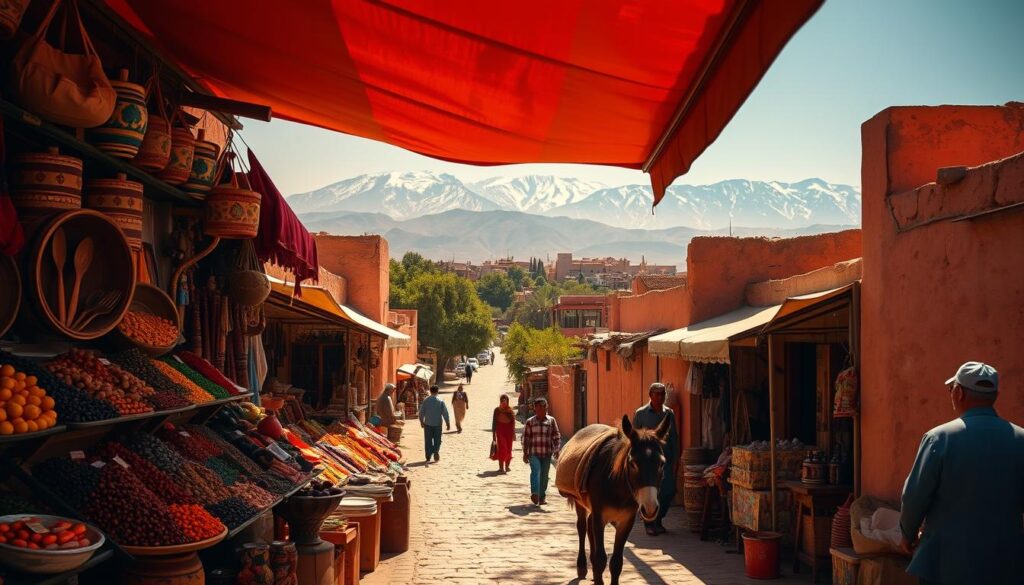
Staying Hydrated and Sun Protection
The sun in Morocco, especially in the desert and summer, is very strong. It’s important to stay hydrated by drinking lots of water. Bring a refillable water bottle to save the environment and always have water.
Use sunscreen with a high SPF to protect your skin. Apply it every two hours, or more if you’re swimming or sweating. Wearing protective clothing, like a hat and sunglasses, also helps.
Packing Recommendations by Season
Choosing the right clothes for Morocco’s weather is key for comfort. In spring and autumn, wear layers because the temperature changes a lot. In summer, wear light, breathable clothes. In winter, especially in the mountains, you’ll need warmer clothes.
- For desert trips, pack light, neutral clothes and a scarf to protect from sand and sun.
- In the mountains, bring warm layers and waterproof stuff, especially in winter.
- At the coast, wear comfy clothes and swimwear, and a light jacket for cooler nights.
Being ready for Morocco’s weather and taking care of your health and comfort can make your trip better.
Itinerary Planning Based on Timing
The best time for a Morocco trip depends on your interests. Morocco’s climate and geography change with each region. This means different times are best for different places.
One-Week Itineraries for Each Season
For a week, pick one area to explore fully. Here are some ideas:
- Spring (March-May): See the imperial cities like Marrakech, Fez, and Meknes. Enjoy the mild weather and blooming flowers.
- Summer (June-August): Go to coastal cities like Essaouira and Casablanca. Enjoy the beaches and cool ocean air.
- Autumn (September-November): Visit the Atlas Mountains for great hiking. Also, see the harvest season in the countryside.
- Winter (December-February): Experience Marrakech’s lively festivals. Also, explore the Sahara Desert, where it’s warmer.
Two-Week Comprehensive Tours by Season
With two weeks, you can see more of Morocco. Here are some plans:
- Spring: Start in Marrakech, then go to the Atlas Mountains. Visit Fez and Meknes, and end in Rabat.
- Summer: Start in Casablanca, then go to Essaouira for beach time. Next, do a desert safari in the Sahara.
- Autumn: See the imperial cities, then go to the Atlas Mountains for hiking. Enjoy the fall colors.
- Winter: Visit Marrakech for its festivals, then go to the Sahara for an adventure. End in Fez.
These plans mix culture, adventure, and relaxation. They’re tailored for the best of each season.
Traveler Types: When Should You Visit?
The best time to visit Morocco depends on what you like to do. Different travelers have their perfect time based on their interests.
Families with Children
Families should visit Morocco in spring (March to May) or autumn (September to November). These times have nice weather. It’s great for city tours, beach fun, or outdoor games.
- Spring: Enjoy mild temperatures and blooming landscapes.
- Autumn: Experience comfortable weather and various cultural festivals.
Adventure Seekers
Adventure lovers find Morocco exciting all year. But, the best time for certain activities changes.
For desert trips, avoid the peak summer months because it’s too hot. The cooler months from October to February are better.
Culture Enthusiasts
Culture fans can enjoy Morocco’s rich heritage at different times. It depends on the festivals and events they like.
- Winter: Experience the Marrakech International Film Festival.
- Spring: Enjoy the Rose Festival in El Kelaa M’Gouna.
Budget Travelers
Travelers on a budget should visit during the low season (November to March, excluding holidays). This time offers the best deals on places to stay and tourist services.
Visiting in the shoulder season (April to May or September to October) is also good. It balances price with nice weather.
Conclusion: Making the Most of Your Moroccan Adventure
Now that you’ve learned about traveling to Morocco, you’re ready to plan your trip. Morocco offers pleasant weather, cultural events, and budget-friendly options all year round. You can find something special no matter when you go.
Think about the best time for sightseeing in Morocco and add travel tips to your plan. Spring and autumn are great for the imperial cities. Summer is perfect for the coast. Winter is ideal for skiing or enjoying the coast’s mild weather.
When planning your Moroccan adventure, research and book early, especially in busy seasons. With good planning, you’ll have a memorable trip and make unforgettable memories.

